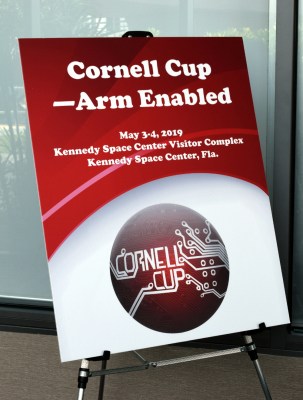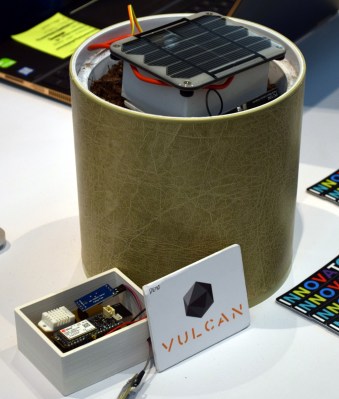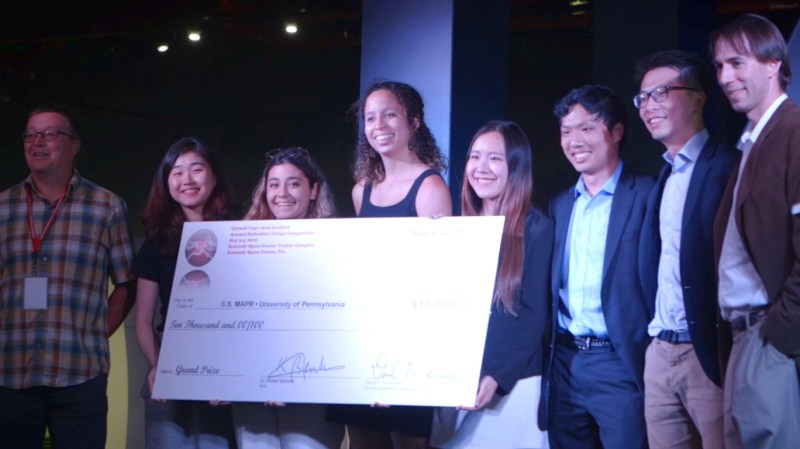For college-aged engineers and designers, finding a problem they’re truly passionate about early on could very well set the trajectory for an entire career. This is precisely the goal of the Cornell Cup, a competition that tasks applicants with solving a real-world problem in a unique and interesting way. From what we saw this is definitely working, as teams showed up with ornithopter-based quadcopters, robotic dinghies, forest fire sniffers, and high-jumping rovers.
 With such an open ended approach, individual entries have a tendency to vary wildly, running the gamut from autonomous vehicles to assistive technology. No team feels pressured to pursue a project they aren’t truly invested in, and everyone’s the better for it.
With such an open ended approach, individual entries have a tendency to vary wildly, running the gamut from autonomous vehicles to assistive technology. No team feels pressured to pursue a project they aren’t truly invested in, and everyone’s the better for it.
Given such lofty goals, Hackaday was proud to sponsor the 2019 Cornell Cup. Especially as it so closely aligns with the product design focus of this year’s Hackaday Prize. Designing something which solves a real-world problem is definitely part of the formula when the goal is to reach large scale production. And after seeing the entries first-hand during the Finals at Kennedy Space Center, we think every one of them would be a fantastic entry into the Hackaday Prize.
I don’t envy the judges who ultimately had to narrow it down to just a few teams to take home their share of the nearly $20,000 awarded. Join me after the break for a closer look at the projects that ended up coming out on top.
First Place: S.S. MAPR
Developed by a team from the University of Pennsylvania, the S.S. MAPR impressed on multiple fronts. It was the only autonomous vehicle to make it into the Finals, and also the only watercraft. Its imposing eight-foot length was also hard to discount in a room largely dominated by tabletop demonstrations. Given its size, there was unfortunately no way for the autonomous boat to show off its moves indoors, but videos recorded during a previous expedition to Pennsylvania’s Schuylkill river were on display for the judges to view.
The team’s goal with S.S. MAPR was to make performing water quality samples faster and cheaper than sending a human out to do it, which in turn helps authorities identify and respond to ecological threats to drinking water sources. Operators provide the locations and depths they want to sample, and the craft uses a submersible pump to bring samples aboard. The 250 mL sample containers are held within a novel rotary mechanism, and there’s a provision for purging the pump and lead hose before sample collection to avoid cross-contamination with the previous sample.
Initially, the team planned to manufacture their own hull, but eventually found it made more sense to use a commercially available inflatable boat as a starting point. For propulsion, they used Blue Robotics T200 thrusters capable of delivering 5.1 kilograms of thrust each; more than enough to get the lightweight inflatable craft where it needs to go. The considerable energy requirements of the craft did prove to be something of a challenge, and the team eventually settled on an onboard 700 watt gasoline generator after finding that pure battery power didn’t deliver the necessary endurance.
Second Place: TerraNova
Not all of the problems tackled during the Cornell Cup were of Earthly origin. It’s theorized that caves on the Moon would make an ideal starting point for a future human outpost, but up until this point, they’ve gone completely unexplored. In lieu of relatively sure-footed human explorers, it would take an exceptionally nimble rover to descend more than a few feet into these caves.
Enter TerraNova. This rover design is not only able to handle rough and uneven terrain, but it has a secret weapon: a spring-loaded vertical leap capability designed to get it out of trouble. On the Moon, the team estimates their system should be able to propel TerraNova one meter into the air without expending any fuel. With the addition of gas thrusters, this ability could potentially be expanded to performing the sort of long-distance horizontal “hops” required by the unclaimed Google Lunar X Prize.
As impressive as the rover is, Team TerraNova has no illusions about their machine actually going to the Moon. But then, that was never really the goal. The hope is that the research and engineering done during the development of their leaping rover could prove useful to NASA or other entities performing future lunar missions. Of course, knowing you don’t have to design your vehicle to operate hundreds of thousands of miles from home has its advantages; namely the ability to use consumer-grade components and swapping out a complex semi-autonomous control system for an Xbox controller hooked up to a laptop.
Third Place: FWMAV
Last but certainly not least is the Flapping-Wing Micro Air Vehicle (FWMAV) from the University of California, Irvine. Essentially, the team took the traditional quadcopter design we’re all familiar with and replaced the spinning propellers with four sets of ornithopter wings. The amalgamation of these two vastly different styles of flight results in a vehicle with the maneuverability of a quadcopter but without the noise and hazardous blades which thus far have been considered part and parcel with small UAVs.
It’s one thing to understand the physics of how it flies, but it’s quite another to see it in the air. The FWMAV doesn’t just fly, it zooms. A side-effect of the ornithopter wings is that the craft is capable of very nearly horizontal flight, but with the hovering ability and pinpoint landing accuracy of a helicopter. We’re told that the team received special dispensation from NASA to fly the FWMAV around the conference center, a decision which was surely appreciated by all those in attendance.
Without the spinning blades, the FWMAV is much safer than traditional UAV designs. You can put your hand against the flapping wings and cause no damage to yourself or the aircraft. While it’s still far from silent, the movement of the wings makes for a far more organic noise than you might expect. Seeing it buzz and flit around the room, it seems more like a giant insect than a mechanical device.
Incredibly, every piece of hardware used in the FWMAV is an off-the-shelf component. From the flight controller to the ornithopter mechanisms, they’re all parts you can buy right now. The trick was combining them in a novel way. According to the team, the hardest part was modifying the flight controller’s open source firmware to handle the new propulsion system.
People’s Choice: Vulcan IoT
 While it didn’t get selected by the judges, Vulcan IoT impressed the Cornell Cup attendees enough that it picked up the “People’s Choice” award at the end of the Finals. This project uses a network of low-cost sensors to try to predict when wildfires will occur by analyzing variables such as air temperature and soil moisture. Comparing real-time data from the sensor network to decades of historical records, the team believes their system can preemptively alert authorities to an imminent fire threat.
While it didn’t get selected by the judges, Vulcan IoT impressed the Cornell Cup attendees enough that it picked up the “People’s Choice” award at the end of the Finals. This project uses a network of low-cost sensors to try to predict when wildfires will occur by analyzing variables such as air temperature and soil moisture. Comparing real-time data from the sensor network to decades of historical records, the team believes their system can preemptively alert authorities to an imminent fire threat.
The success of the system essentially depends on having a large network of reporting nodes, so looking ahead, the team wants to drive the sensor cost down as low as possible. At this early stage they’re still using CNC milled PCBs and 3D printed enclosures, but those will give way to professionally fabricated boards and injection molded cases as the sensor network expands.
Right now the prototypes are using Particle Electron microcontrollers, which they feel is overkill for the final hardware. As the design progresses towards higher production rates, they’ll look into finding a MCU that’s more closely honed to their specific needs. In the future, the team says an open API could even allow sensors built by other manufacturers (or even individuals) to push data into their system, ultimately paving the way for Vulcan IoT to offer fire detection as a service.
More than a Competition
We wanted to specifically showcase the entries that came out on top at this year’s Cornell Cup, but the event is really so much more than a handful of winning projects. Everyone we talked to said the true value of the Cornell Cup wasn’t the prize money, but the chance to network with other teams and see how the various problems were being solved. As every project is tackling a different problem, the teams see themselves less as competitors and more like colleagues; allowing for a freer exchange of information than you’d likely see if all the teams were working towards the same end goal.
In the hopes of capturing a little bit of the energy and camaraderie that events like the Cornell Cup foster, we’ve put together a video that features some of the passionate students and staffers we talked to during the two day event.




















Awesome, I wish I could have been there!
That ornithopter is amazing, it looks like harnessed butterflies! And the Vulcan is a great idea, depending on how hardy it is the data could be used to preemptively water bomb areas of a forest before they catch on fire.
The ornithopter is beautiful. The autonomous boats looks a lot like the one eTrac made in 2008.
Dangit, I got bored with quads but now I feel the need to build an ornithopter….
I hope they release instructions for the ornithopter along with the firmware edits